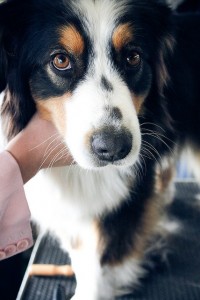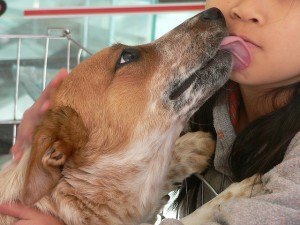Do you ask your dog to do things for you or do you tell them to do them? Trainer Eric Brad believes that how we think about working with our dogs matters. It affects our expectations and can lead to cooperation or conflict. It seems to be an AND/OR proposition.
 I train my dogs using behavioural science. That means that my training is based on a simple principle that B.F. Skinner put forward over 50 years ago – “consequence dictates behaviour.” Whatever happens after my dog performs a behaviour will influence whether she is more or less likely to offer that behaviour again. The science of Operant Conditioning defines this as a reinforcing (more likely) or a punishing (less likely) consequence.
I train my dogs using behavioural science. That means that my training is based on a simple principle that B.F. Skinner put forward over 50 years ago – “consequence dictates behaviour.” Whatever happens after my dog performs a behaviour will influence whether she is more or less likely to offer that behaviour again. The science of Operant Conditioning defines this as a reinforcing (more likely) or a punishing (less likely) consequence.
But there is a bit more complexity to this simple equation. What exactly was it that I did after my dog performed the behaviour? The simplest question to ask is did I add something to the situation or did I take something away? For example, I could have “added” a food treat to the situation for my dog to eat or I could have “taken away” my attention from her. Operant Conditioning calls this “positive” (adding something) and “negative” (taking something away).
So combining how the consequence occurred after the behaviour with whether the behaviour became more or less likely to happen again, we end up with four different combinations:
Positive Reinforcement (adding something to make a behaviour more likely)
Negative Reinforcement (removing something to make a behaviour more likely)
Positive Punishment (adding something to make a behaviour less likely)
Negative Punishment (removing something to make a behaviour less likely)
It’s important to remember that determining whether something is reinforcing or punishing (makes the behaviour more or less likely) requires us to observe what ACTUALLY happens with that behaviour over time. It has nothing to do with your intention as a trainer. If you give your dog a treat every time she sits and she is sitting less and less, then that “treat” is actually punishing the sit behaviour because it is becoming less likely over time. It has nothing to do with my intention to punish my dog in the usual sense.
Playing Along At Home
Here’s the interesting thing. You can look at any dog training method and see which form of Operant Conditioning is being employed to make the behaviour work! When you watch your favorite TV dog trainer, watch to see what’s going on. Does he add something or remove something in a given situation? Does the targeted behaviour increase or does it decrease as a result of the trainers actions? This will tell you whether the technique is “reinforcing” or “punishing” to the behaviour and whether the trainers consequences were “positive” (adding something) or “negative” (removing something). Try it and see for yourself what’s going on from an Operant Conditioning perspective.
 Your local obedience trainer may give a tug at the leash when their dog strays too far from the “heel” position. What bit of Operant Conditioning is at work here? Positive Punishment. When the dog does something other than heel, they add the tug at the leash. Over time the dog will start to avoid the behaviour that gets the tug. Adding the tug has decreased any behaviour other than the correct heel position. And that’s just one application of Operant Conditioning to a dog training scenario. Can you think of others?
Your local obedience trainer may give a tug at the leash when their dog strays too far from the “heel” position. What bit of Operant Conditioning is at work here? Positive Punishment. When the dog does something other than heel, they add the tug at the leash. Over time the dog will start to avoid the behaviour that gets the tug. Adding the tug has decreased any behaviour other than the correct heel position. And that’s just one application of Operant Conditioning to a dog training scenario. Can you think of others?
All training will fit one of the quadrants of the Operant Conditioning model. Trainers who use “time outs” are using Negative Punishment, for example. Removing the dog’s freedom to interact with them in order to diminish an unwanted behaviour. First determine if something is being added or taken away and then observe if the target behaviour becomes more likely or less likely over time. Dog training isn’t such a mystery after all!
And/Or Dog Training
In thinking about all of this, I came across an interesting phenomenon. If we think of the behaviour we are asking for, how do we determine what the consequence will be? As trainers, it is always our decision what the consequence will be. So I wonder what the trainer’s inner voice says when asking for the behaviour? I think that’s an important question.
“Do what I ask AND this will happen.”
“Do what I ask OR this will happen.”
It doesn’t sound like much of a distinction. The small difference between AND and OR seems like a simple semantic choice but it speaks to a much more important mind set. Think about it. Almost naturally the mind seems to fill in the blanks – “Do what I ask and you will get this” versus “Do what I ask or ELSE.” One seems like a natural offer while the other sounds like a natural threat.
Reasoning With Canines
Compared to humans, our dogs have very limited reasoning capabilities. That said, they have demonstrated extraordinary abilities to recognize our signals and remember the consequences of their actions. Science has proven that dogs can remember a cue you have given them for up to 20 minutes and that they are capable of learning upwards of 200 different verbal cues. And this is to say nothing of the hundreds of visual cues they watch and react to every day in our homes.
Here’s a question to ponder: Do our dogs learn anything about us in the process? This is where that AND/OR thing comes back into the discussion. When we give them a cue or command, are we making them an offer (AND) or are we implying a threat (OR else). And does this affect the way they approach their life with us?
I think that it does matter. Our relationship with our dog can have a profound affect on not just his response to our cues and commands but also to his behaviour in our everyday life. Think about it. How would you feel if your life was full of “do it or else” choices? I know I’d be pretty cranky most of the time. At the very least I don’t think I would have much to look forward to everyday.
“Do this for me AND you will get something for your efforts.” That just seems like a much better deal to me than “do it OR else.” I much prefer a cooperative relationship with my dogs. I just find that things work out better that way for me. I like playing agility with my dog and I want a dog that eagerly anticipates another chance to go and “play” that game with me. I can’t imagine telling my dog to “go jump OR else.” I can imagine that in a short time, my dog would be as worried about what might happen if they missed the jump as the did about what might happen if they did it successfully.
This AND/OR phrasing gets to our inner dialog as well. How we think about working with our dog can affect our attitude toward him. If I offer my dog something for his efforts and he don’t do it, oh well, he lost out on a deal I guess. However, if I tell him to do it OR ELSE and he doesn’t do it, now I’m sort of on the hook to follow through with the consequences.
My experience with our dogs in the past 10 years tells me that the cooperative approach is much less stressful than the old confrontational approach we used to use. Helping our dogs understand that there is a payoff for working with us has given us enthusiastic and happy dogs. That just wasn’t true before. Did we get results? Of course. But they weren’t nearly as satisfying.
Until next time, have fun with your dogs.
Photo credits –
Well? – jpctalbot 2008 from Flickr
Deal – powazny 2010 from Flickr
Kisses – basykes 2005 from Flickr
Feature Image – Field Dogs –Linda Cronin 2011 from Flickr





I love this one! I’ve used the and/or explanation many times in classes and I agree that it matters greatly.